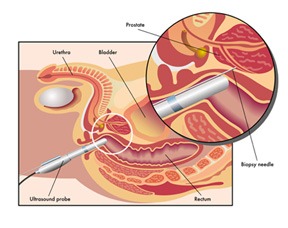A transrectal ultrasound (TRUS) is a procedure which utilizes sound waves to create an image of the prostate gland and the surrounding tissue. Generally the scan requires the insertion of an ultrasound probe into the patient’s rectum. The probe then both sends and receives sound waves through the rectal wall into the prostate gland which is situated directly in front of the rectum.
When do you need a transrectal ultrasound?
A transrectal ultrasound is done for a number of reasons which include:
- To determine whether the prostate is enlarged, also referred to as benign prostatic hyperplasia (BPH)
- If a doctor suspects the presence of the diseases because of an increase in a patient’s PSA level
- Aid in diagnosing the cause of infertility in a patient
- Detecting any abnormalities that are felt during a digital rectal examination (DRE)
Additionally, a TRUS can be used to help guide a doctor with other medical procedures such as a prostate biopsy. Through the prostate ultrasound, the doctor collects a sample of cells or tissues from the abnormality, to be examined under a microscope. This way, cancerous cells can be detected in the prostate.
How is a TRUS performed?
A prostate ultrasound is typically performed as an outpatient procedure and usually takes about 15-30 minutes to complete. Prior to the procedure, the patient will be asked to avoid aspirin for at least 7-10 days, as it can thin the blood. One hour before the TRUS procedure, the patient has to take an enema to clean out the colon and urinate to empty their bladder as much as possible.
The patient will wear a gown throughout the procedure and will be asked to lay on their on their side with their knees bent close to their chest. A protective cover is then placed on the ultrasound transducer (probe), lubricated and placed into the rectum. The patient may feel a sensation of fullness or pressure in their rectum after the transducer is inserted.
The transducer will then direct high-frequency sound waves at the prostate gland and the echoes created by the sound waves will generate an image of the prostate gland on a monitor for the doctor to analyze for any abnormalities. When the TRUS procedure is completed, you will be asked to dress and wait while the ultrasound images are given further analysis.
Side effects of the transrectal ultrasound
As with any type of medical procedure, there is always potential for side effects which will vary among patients. However side effects of a TRUS only occur when used during a prostate biopsy. Some of these side effects include:
- A minimal amount of rectal bleeding several days following the TRUS scan
- Biopsy sites will be sore for several days following the biopsy
- Blood may present in urine, stool and semen for several weeks following the procedure
- In very rare instances there may be swelling of the prostate making it difficult for a patient to urinate.
Understanding your results
If the doctor discovers any abnormalities in the prostate, the doctor will then decide whether further testing is required. Abnormal findings in a transrectal ultrasound probe can include:
- An enlarged prostate (benign prostatic hyperplasia or BPH)
- An inflamed or infected prostate (prostatitis)
- Prostate cancer


